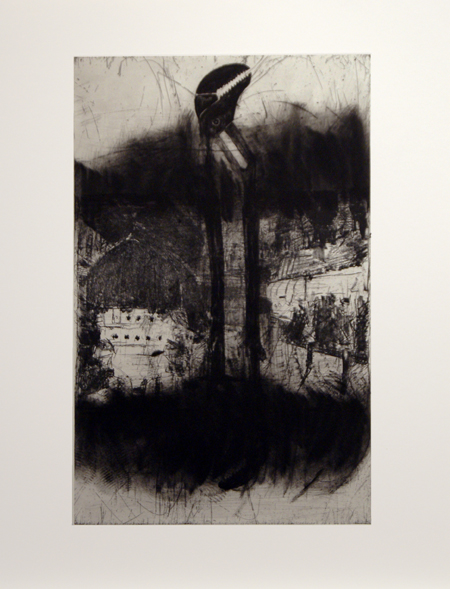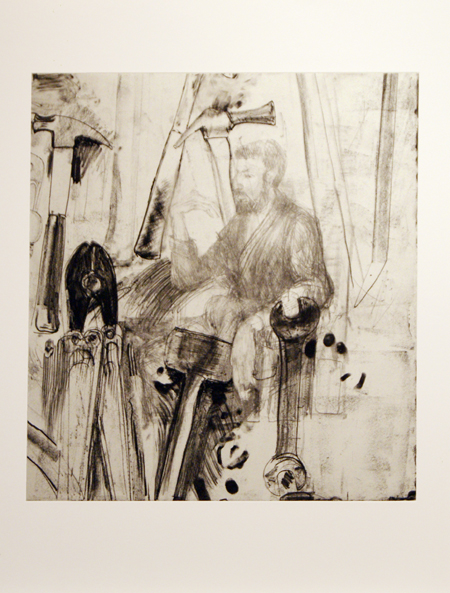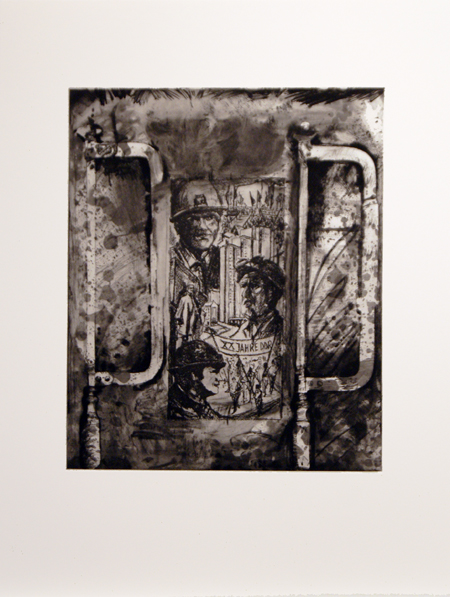Collector and gallerist Alan Cristea talks us through the printmaker’s latest body of work, bringing to light never-before-seen drawings by Eastern Bloc artists

One of the most significant artists of his generation, and arguably the greatest living print-maker working today, American artist Jim Dine is the subject of a double exhibition currently underway at London’s Alan Cristea Gallery. A History of Communism brings to light a series of Dine prints, that make use of ‘never-before-seen drawings by Eastern Bloc artists’, working during the Cold War period in the German Democratic Republic.
Gallery owner, Alan Cristea, talks us through the body of work, and his relationship with the artist, whose work spans six decades.
How long have you known Jim, and how did you first discover his work?
I would first been aware of his work as an art history student in Cambridge in the late 60s. I first met him in 1978: I had lunch with him, and because I admired his work, he asked if I would act as European distributor for his prints, which I’ve been doing ever since.
Is Dine still as active artistically, now he’s in his late 70s as he was 20 years ago?
Definitely. He’s super fit, super active, and work is his life. He has houses in Washington State, a studio in Paris and a studio in Göttingen, and wherever he goes, he makes prints.
“I think he liked the idea of crossing both a temporal divide and a cultural one by appropriating
these images and turning them into his own”
How were the prints that comprise A History of Communism & Jim Dine physically constructed?
One of the cities where he makes prints is Berlin. There are two printers there that he likes very much, and on one visit, they showed him a hundred lithographic stones which they’d been given, which had been made by students at an art school in what was the German Democratic Republic – East Germany. He was fascinated by them, and asked them to revive the plates, to revive the stones, clean them up and make them fit for printing.
They printed editions from 45 of the stones, then shipped them to his studio in Washington. When he got them, he worked on etching plates, and the resultant image from those etching plates was printed on top of the prints from the original lithographic stones.


The artists behind the stones are unknown: do you think Jim was thinking about the anonymity of collective communism when he was working with them?
It’s difficult to comment too closely, as every human being is different, and so his answer is different to mine. However, Jim is of Polish origin. He doesn’t speak Polish – he has no connection to the country, yet he’s chosen to spend half his adult life in Europe. In spending so much time in Europe, and being Jewish, he’s obviously very aware of European history, and like so many of us who have no first hand knowledge of day-to-day life in the Soviet Union, or indeed in DDR, I think he was rather fascinated by the idea.
A lot of the images the students did are clearly images that relate in some way to the totalitarian regime. I think he liked the idea of crossing both a temporal divide and a cultural one by appropriating these images and turning them into his own. As to exactly the nature of that fascination…
How does this series fit into his larger body of work?
Because he is a print maker, but he works with printers. The printers enable him to realise his ambitions as a print maker. You can’t really talk of a collaboration with students in the DDR, because it’s an act of appropriation rather than one of collaboration.
The reality of it is once you get going on a print making project, you’re getting your hands dirty, you’re carving, you’re biting, you’re not constantly standing there thinking, ‘What happened in the DDR?’ You’re thinking about what you’re doing now, marks you are making. So whereas it’s a fascinating subject, to gleam from that any one particular socio-political message would be a mistake. People can interpret as much as they like.
That said, it fits very much within the context of his work overall, because by far the majority of the subject matter which he’s chosen to superimpose on these pre-existing images is tools. Jim’s mother died when he was very young, his father wasn’t around, and so he was brought up by his grandfather who owned a tool shop in Cincinnati. Tools were his earliest subjects, and they’ve never left his work; pliers hammers etc. It happens that tools are a sometimes used as national emblems, most famously the Soviet Union’s hammer and sickle.
What is it about about Jim’s work as a gallerist that draws you back to it again and again?
The trouble is that the world prolific in most peoples’ vocabulary when talking about art is a negative. Prolific for me is a positive; if you think about the best artists of the twentieth century, they are prolific. Think about Picasso – prolific; Matisse was prolific. Most of the best ones are.
The use of the word prolific these days is a market description; if the market says ‘prolific bad’, ‘very few works’ becomes ‘good’. One of the reason I chose to deal in prints – and I don’t mean reproductions, I mean editioned prints – is because they reach a far wider audience because there are more of them. In a sense, it’s a more democratic form than a world which is exemplified by someone paying 50 million quid for a painting at Sotherby’s or Christie’s.
When I think back to previous centuries, about Japanese woodcuts, which are just so wonderful, they were done in unlimited editions and were available very cheaply. Because I’m into prints, Jim Dine is possibly the greatest living print maker. He has used every single method and invented quite a few of his own. For example, his use of electric tools on etching plates, that wasn’t something anyone had ever done before. My passion for prints is echoed by his passion for prints. I’m far more interested in that than the world of mega-expensive paintings.




